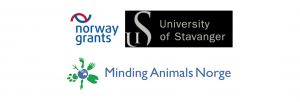CFP: Animals in the Anthropocene Human–animal relations in a changing semiosphere
FIRST CALL FOR PAPERS
Animals in the Anthropocene
Human–animal relations in a changing semiosphere
Stavanger, Norway, 17–19 September 2015
Organised by the Norwegian research group of the Norwegian-Estonian research project “Animals in Changing Environments: Cultural Mediation and Semiotic Analysis” (EEA Norway Grants/Norway Financial Mechanism 2009–2014 under project contract no. EMP151). The research project is carried out in cooperation between University of Stavanger (Norway) and University of Tartu (Estonia).
Co-organised by Minding Animals Norway.
Venue: Kjell Arholms hus, University of Stavanger (Ullandhaug campus)
Confirmed keynote speakers (more to be announced):
Almo Farina (Italy)
Gisela Kaplan (Australia)
Dominique Lestel (France)
Louise Westling (USA)
Theme
Environmental change occurs at various levels, from the global to the local. As the environment undergoes change, the living conditions of animals change, and people’s perception of animals change. The dynamics of these processes are complex – in some cases, environmental change directly influences human–animal relations, in others human cultural mediation of animals contributes to environmental change.
Most but not all of current environmental change is anthropogenic. The term the Anthropocene (the era of humankind) is increasingly acknowledged as suitable for our current geological epoch. Some think that the beginning of the Anthropocene coincided with the industrial revolution or the massive ecological changes that have followed it. Others argue that humankind’s global impact, and thus eventually the Anthropocene era, started shortly after the advent of agriculture.
At any rate adaptation to environmental change is in our time an important factor in the lives on most animal species, whether they are domesticated or captive, or wild. By establishing a global colonial organism of sorts, humankind has in effect installed an ecological empire, hierarchically organised with Homo sapiens on top and with crop species, pets and livestock in privileged positions. Thereby we have further provided global breeding grounds for other species that might not otherwise have been able to spread at a global scale – from rats and doves to bugs and microbes of various sorts.
Studying the nature of the relations between animals, environmental change, and human cultural mediation has pivotal importance for understanding ecological and ethical conflicts involving animals. Such studies furthermore have the potential of helping to induce better practices of species protection and wildlife management, husbandry practices, and environmental communication. A useful tool for these studies is semiotics, including semiotics of nature, where Juri Lotman’s notion of the ‘semiosphere’, originally meant for cultural semiotics, has been expanded to denote the space, or sphere, of signs in a biosemiotic sense. All animals relate to signs and make use of signs – they live in worlds of signs (i.e., Umwelten, in Jakob von Uexküll’s terminology), and their perception and action is always mediated by signs. The global semiosphere therefore coincides with the biosphere.
We welcome submissions with paleontological, archaeological, historical, contemporary and future-oriented perspectives. Submissions may present local or global case studies, or consist of theoretical/methodological contributions. Relevant fields of study include in particular:
– human-animal studies/anthrozoology, critical animal studies
– semiotics of nature (biosemiotics, ecosemiotics, zoosemiotics), cognitive semiotics
– environmental humanities, ecocriticism, ecolinguistics, posthumanism
– paleontology, archaeology, environmental history
The following fields of study are also potentially relevant:
– anthropology, environmental sociology, green criminology, political science, ecological economics
– biology (ethology, comparative psychology, conservation biology, ecology, veterinary medicine)
– geology, earth science, climate research
– philosophy (philosophy of biology, philosophical anthropology, eco-phenomenology, animal ethics, environmental ethics)
Session proposals
Theme session proposals should introduce the proposed theme and explain its relevance to the overall conference theme. Length: 400-600 words. Please include your full name and affiliation, and full name and affiliation of co-chairs, if any.
Theme session proposals may or may not include a list of pre-arranged abstracts (oral presentations). However, all abstracts must be submitted by the prospective presenters themselves.
Deadline for submission of theme session proposals: December 15th 2014.
Notification of acceptance of theme session proposals will be given by January 15th 2015.
Please submit your theme session proposal to anthropoceneanimals@uis.no.
Abstracts
Abstracts (oral presentations) should describe a relevant topic, how the prospective presenter(s) approaches it, and results/conclusions. Length: 200-400 words. Abstracts may be submitted at any time from the first call for papers appears and until the deadline. Please include your full name(s) and affiliation(s).
Deadline for submission of abstracts (oral presentations): March 1st 2015.
Notification of acceptance of abstracts (oral presentations) will be given by April 30th 2015.
Please submit your abstract to anthropoceneanimals@uis.no.
Second call for papers
A second call for papers, including a list of accepted theme sessions, will be distributed in January 2015.
Registration
Registration for the conference will open in May 2015. The conference registration fee will cover lunch (vegetarian) and coffee breaks for three days, and a program booklet. Registration for conference dinner and a guided tour is optional.
More information on the conference website.
See also the homepage of the Norwegian research group and the homepage of our Estonian partner.
Local Organising Committee: Morten Tønnessen (Chair), Laura Kiiroja (Communication officer), Kristin Armstrong Oma, Paul Thibault.
Scientific Advisory Committee: Frode Bakke Bjerkevik, Laura Kiiroja, Timo Maran, Nelly Mäekivi, Kristin Armstrong Oma, Silver Rattasepp, Paul Thibault, Kadri Tüür, Morten Tønnessen.



Leave a Reply
You must be logged in to post a comment.